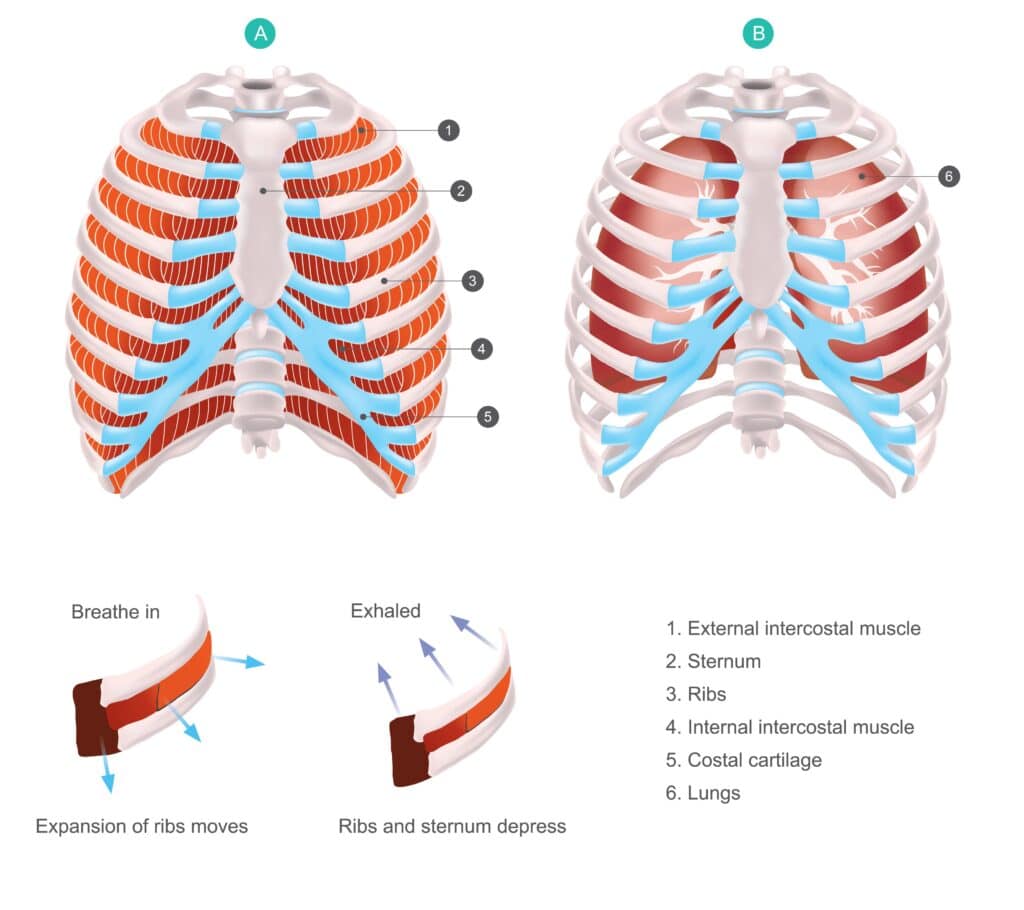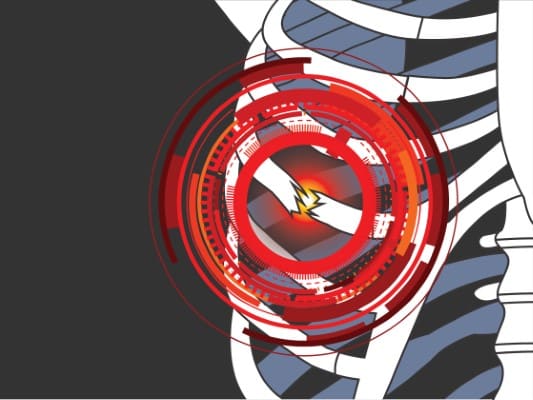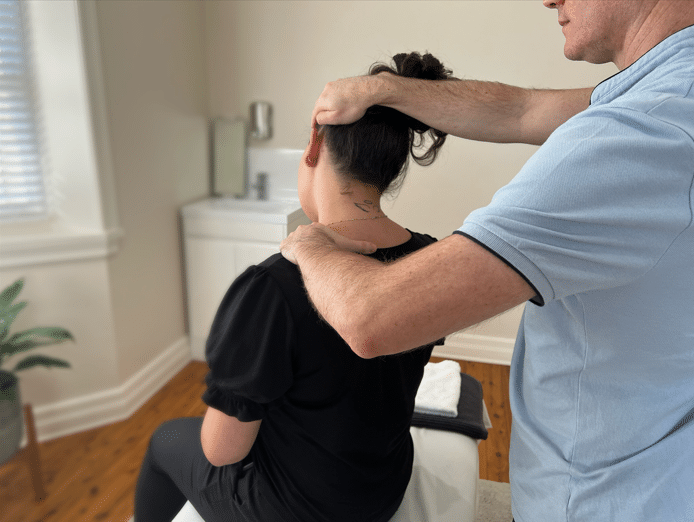- 02 9712 1736
- [email protected]
- 212 Great North Road, Five Dock, NSW 2046
- Open 7 days a week
Rib cage pain is often due to musculoskeletal issues like muscle strains, costochondritis, rib fractures, or slipping rib syndrome. In this article we explains the common musculoskeletal reasons you have rib cage pain and offers practical tips for management and treatment.

The rib cage is a marvel of human anatomy, providing both protection and support to vital organs while aiding in respiration. It is composed of 12 pairs of ribs, the thoracic spine, the sternum, and intercostal muscles. The first seven pairs are known as true ribs, attaching directly to the sternum, while the next three pairs are false ribs, connecting to the sternum indirectly through cartilage. The last two pairs, ribs 11 and 12, are referred to as floating ribs because they do not attach to the sternum.
Five major muscle groups are associated with the rib cage, including the external, internal, and innermost intercostals. These muscles play a crucial role in the mechanics of breathing. The external intercostal muscles elevate the ribs and increase thoracic volume during inhalation, while the internal intercostal muscles have two parts: one that elevates the ribcage during inhalation and another that depresses it during exhalation.
The intercostal muscles, situated between the ribs, are vital for the mechanics of breathing. These muscles can become strained from overuse or trauma, leading to significant pain in the chest wall. Understanding the anatomy of the rib cage helps in identifying specific areas where pain might originate from and the muscles or bones involved.
Such detailed knowledge of the rib cage’s structure and function is essential for diagnosing and treating rib cage pain effectively. Whether dealing with bruised ribs, rib fractures, or conditions like slipping rib syndrome, knowing the underlying anatomy provides a clearer path to relief and recovery
Musculoskeletal chest pain is a prevalent issue in general chiropractic, physiotherapy and osteopathic practice. The muscles, bones, or connective tissues of the chest wall usually cause musculoskeletal chest pain. Isolated musculoskeletal chest pain and non-cardiac-related chest pain is an important consideration when diagnosing chest pain. Commonly, musculoskeletal pain is constant and localised, unlike cardiac-related pain that can radiate, generally into your left shoulder, left arm or abdominal region.
Musculoskeletal chest wall pain is often a result of:
Musculoskeletal chest wall pain can be particularly troublesome as it impacts daily activities and overall quality of life. Understanding the common causes of musculoskeletal chest pain is the first step towards effective treatment.
The following subsections will delve into specific conditions that frequently cause rib cage pain: muscle strains, costochondritis, rib fractures, and slipping rib syndrome.


Muscle strains in the chest wall are often the result of trauma or repetitive use. Activities that involve repetitive movements, such as heavy lifting or certain sports, can lead to overuse and subsequent muscle strain. The symptoms of a chest muscle strain typically include localized pain that worsens with movement.
Treatment for muscle strains generally involves hands-on care, pain management and rest. Over-the-counter pain relievers, ice packs, and avoiding activities that exacerbate the pain can help in the healing process. Physical therapy to relieve the muscle strain and promote blood flow is important for pain relief and quicker healing. Stretching exercises may also be beneficial once the acute pain subsides.
Costochondritis is the inflammation of the cartilage connecting the ribs to the sternum. This condition often presents as pain in the rib area that can be reproduced by pressing on the affected spot. Diagnosis is primarily clinical, as there are no specific laboratory or imaging tests for costochondritis.
Physical therapy to help reduce inflammation and painkillers are essential in treating costochondritis. Anti-inflammatories, medication, and therapies play a vital role in the healing process. Due to a lack of clinical trials and low-level evidence for treatment approaches, managing this condition can sometimes be challenging. Alternative treatments may be considered if pain management is ineffective.

Rib fractures typically result from significant trauma, such as car accidents or falls. However, stress fractures can also occur due to repetitive activities, particularly in athletes. The symptoms of rib fractures include sharp pain that worsens with breathing or movement.
The treatment for rib fractures usually involves pain management and allowing the bone to heal naturally. Severe cases may require more intensive medical intervention, but most rib fractures heal with rest and appropriate pain relief.
Slipping rib syndrome occurs when the lower ribs loosen from their fibrous connection to the breastbone, often due to trauma. This can cause pain in the lower chest or abdomen. The pain might radiate to the abdomen, making it difficult to pinpoint.
Conservative treatment for slipping rib syndrome typically involves activity modification to prevent further injury. In some cases, surgery may be required to stabilize the affected ribs.
Beyond the common causes, other musculoskeletal conditions can also lead to rib pain. These issues often stem from problems affecting the muscles, bones, and nerves. For example, different types of arthritis, fibromyalgia, anxiety or tension can cause rib pain. Alternatively, repetitive coughing from pneumonia or bronchitis can cause rib pain. Both musculoskeletal causes and serious conditions can lead to rib pain, making accurate diagnosis crucial.
Understanding these conditions is essential for proper diagnosis and effective treatment.

Fibromyalgia is a condition characterized by chronic pain and heightened sensitivity to pain, making rib pain more pronounced. Individuals with fibromyalgia often experience chronic rib pain as a common complaint.
Managing fibromyalgia-related rib pain involves a combination of pain management strategies and lifestyle modifications. Understanding the link between fibromyalgia and rib pain can help in developing effective treatment plans.
Rheumatic diseases, such as rheumatoid arthritis, ankylosing spondylitis, and psoriatic arthritis, are known to cause chest wall pain. These conditions lead to inflammation and joint issues, resulting in rib cage pain.
Treatment for rib pain caused by rheumatic diseases often involves managing the underlying condition with medications and physical therapy. Early diagnosis and treatment are crucial to prevent long-term damage and improve quality of life.

Diagnosing musculoskeletal rib cage pain involves a thorough evaluation, including a review of medical history, symptom assessment, physical examination, and potentially imaging tests. As discussed rib pain can arise from various factors, including musculoskeletal conditions. Consulting a healthcare provider is essential to confirm the diagnosis of musculoskeletal chest pain and make sure you receive the right treatment.
Healthcare providers will often ask specific questions about symptom patterns to help refine the diagnosis. The clinical evaluation process includes assessing the tenderness area, range of motion testing and conducting a hands-on physical examination where you have rib pain. Imaging tests, such as chest X-rays or MRI, are often indicated to rule out rib fractures or assess inflammation.
Accurate diagnosis is critical to ensure appropriate treatment and to rule out more serious conditions. Identifying whether the pain is musculoskeletal, lung-related or cardiac-related can significantly impact the treatment approach and outcomes.
Various treatment strategies aim to relieve pain and support recovery from rib cage issues. These strategies include physical therapy, medication, and lifestyle adjustments. Treatment options for slipping rib syndrome, for example, include conservative management like modifying activities.
The RICE method (Rest, Ice, Compression, Elevation) is often recommended for muscle strains, sprains, and soft tissue injuries. The following subsections will detail specific treatment options, including rest and activity modification, chiropractic, osteopathic, physiotherapy hands-on care, and medication.
Resting and modifying daily activities are crucial for preventing additional injury and aiding recovery. Taking breaks from aggravating activities, such as strenuous exercise or heavy lifting, can significantly aid in recovery from rib cage pain.
Prioritizing rest and mindful activity modification can enhance healing and prevent future injuries. Simple adjustments in daily routines can make a significant difference in managing rib pain effectively.
Chiropractic, osteopathy and physiotherapy all play a vital role in managing musculoskeletal rib pain through thorough assessment and treatment. After acute care, a tailored program of stretching and strengthening exercises for the chest wall can significantly improve mobility and reduce pain.
Exercises like chest expansion and thoracic rotation are commonly recommended to enhance flexibility and support good posture. Strengthening exercises introduced post-injury help maintain good posture and reduce the risk of future injuries.

Non-steroidal anti-inflammatory drugs (NSAIDs) are commonly used to alleviate pain associated with rib injuries, including costochondritis. Applying heat or cold can manage pain and swelling effectively.
Using NSAIDs and ice packs can help manage inflammation and pain, emphasizing a comprehensive approach to pain management. Medications play a significant role in managing rib cage pain and can greatly enhance the recovery process.
Chest pain should always be taken seriously and evaluated as potentially heart-related until proven otherwise. Severe chest pain always requires immediate medical assistance. Signs of a heart attack include discomfort in the chest and pain radiating to the arms, jaw, or back. However, pain is not the only heart-related symptom. Nausea, dizziness, cold sweat and shortness of breath are all related to heart symtpoms.
If you experience severe ribcage pain accompanied by alarming symptoms, seek emergency medical attention at the local Accident and Emergency department or call 000 for an ambulance. Do not ignore severe symptoms; they can be indicative of life-threatening conditions.

Understanding the musculoskeletal causes of rib cage pain is crucial for effective diagnosis and treatment. From muscle strains to costochondritis, rib fractures, and slipping rib syndrome, identifying the root cause can significantly aid in managing pain and improving quality of life. Remember to seek emergency medical attention for severe or persistent symptoms to rule out life-threatening conditions.
Forest Lodge, Annandale, Glebe, Leichhardt, Balmain, Haberfield, Canada Bay, Rozelle, Rodd Point, Wareemba, Stanmore, Petersham, Lilyfield, Hunters Hill, Enfield, Cabarita, Mortlake, Rhodes, Burwood Heights, Birchgrove, Gladesville, Huntleys Point, Abbotsford, Ashfield, Croydon Park, Croydon, Chiswick, Russell Lea, Burwood, Strathfield, Concord, Drummoyne, North Strathfield, Liberty Grove, Dulwich Hill, Lewisham, Camperdown, Ashbury, Homebush, Homebush West, Woolwich, Henley, Summer Hill, Sydney Olympic Park


About
Five Dock Osteopathic & Chiropractic is located in Canada Bay, in Sydney’s Inner West. Servicing suburbs including Burwood, Croydon, Drummoyne, Five Dock, Haberfield, Concord, Abbotsford, Chiswick, Leichhardt, Wareemba, Russell Lea, Summer Hill, Strathfield.
Clinic hours
Monday, Tuesday, Thursday 7AM – 7PM
Wednesday, Friday 7AM – 6PM
Saturday 7AM – 2PM
Sunday 8AM – 2PM
Contact details